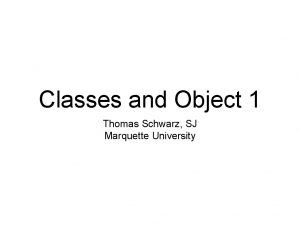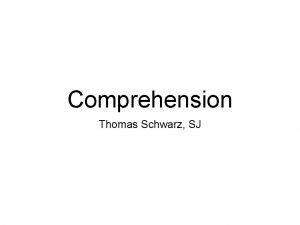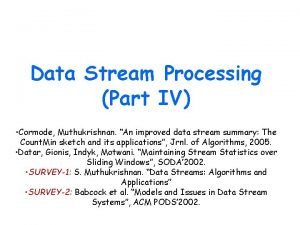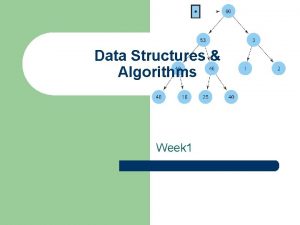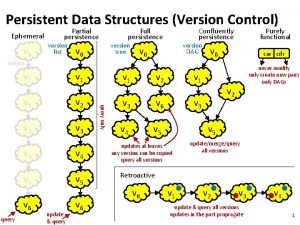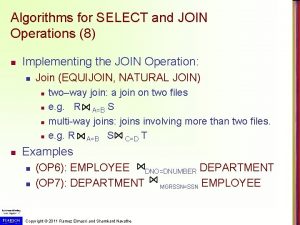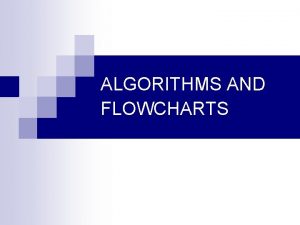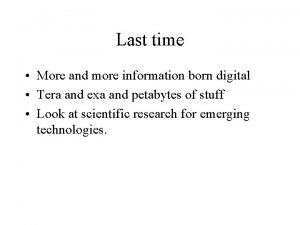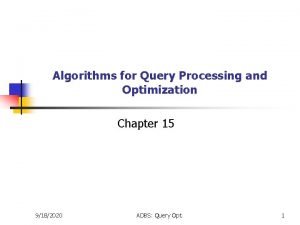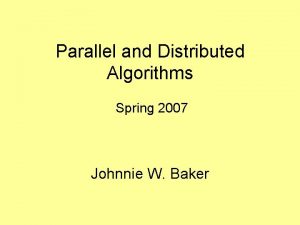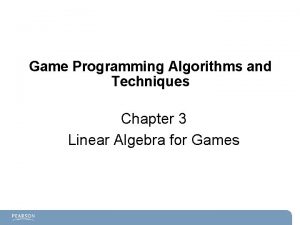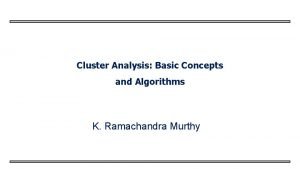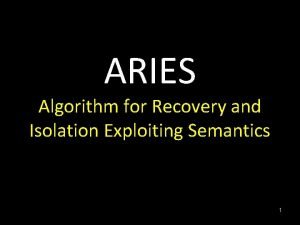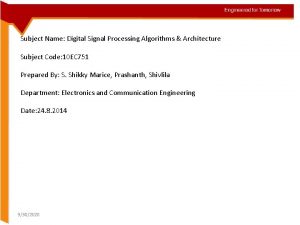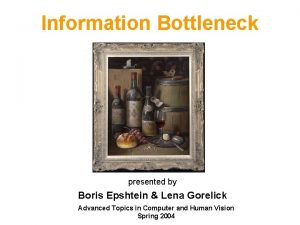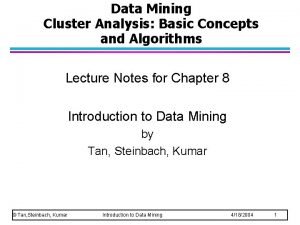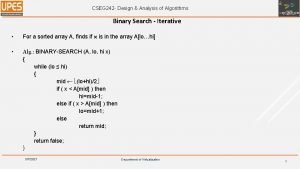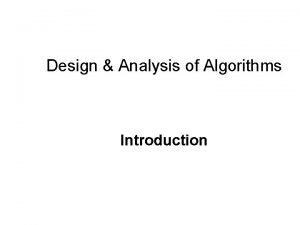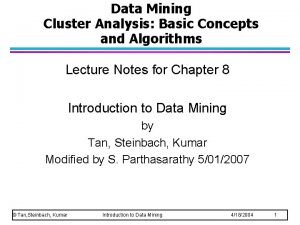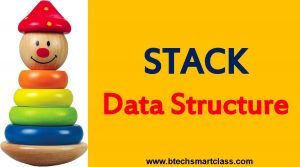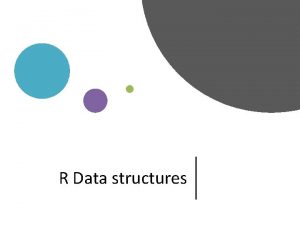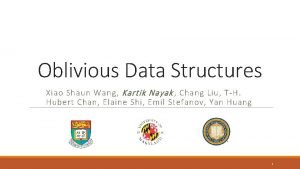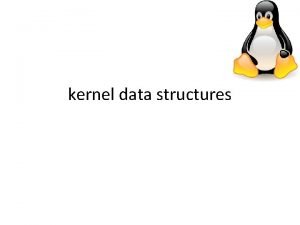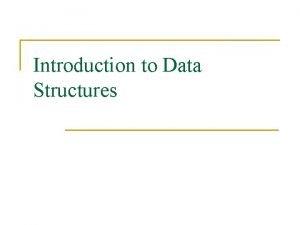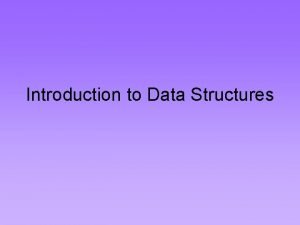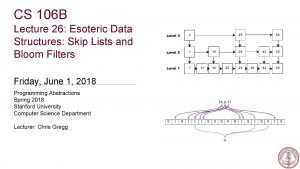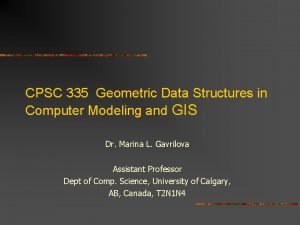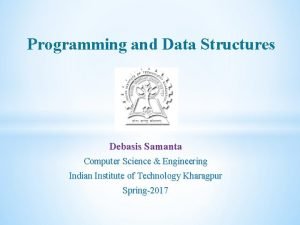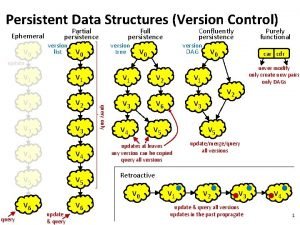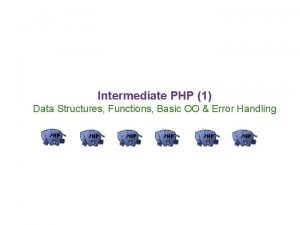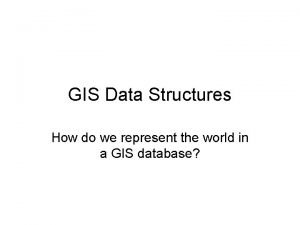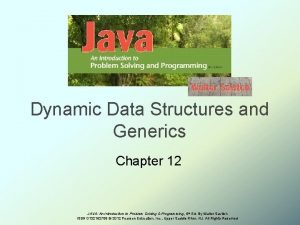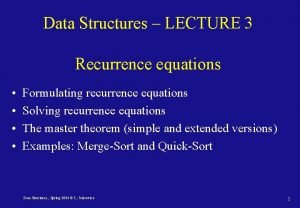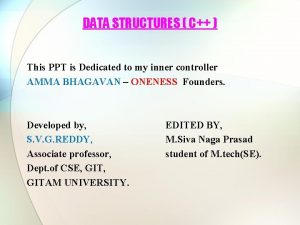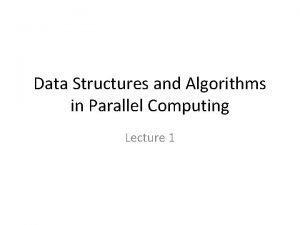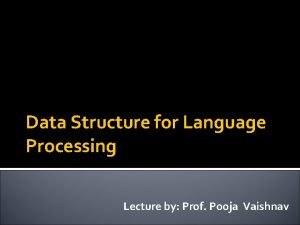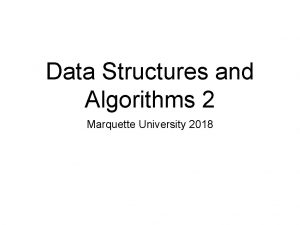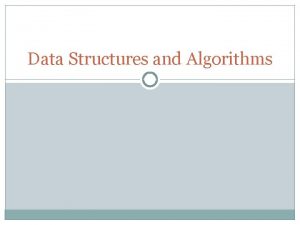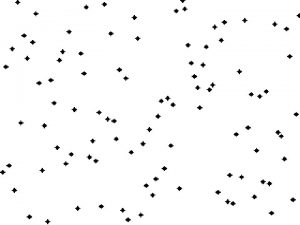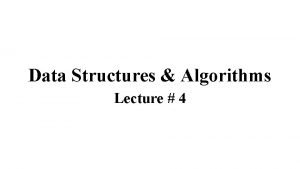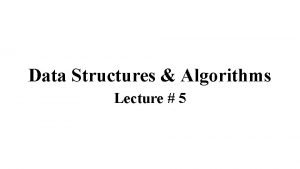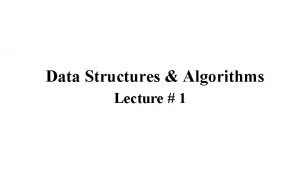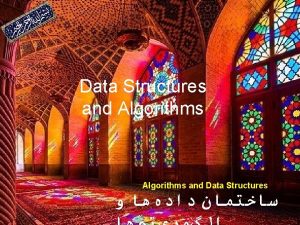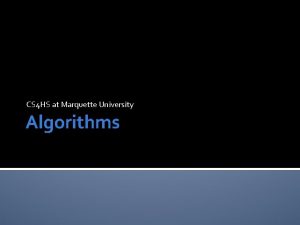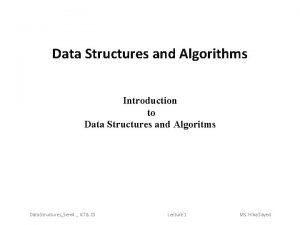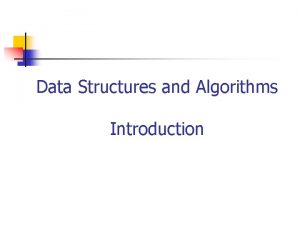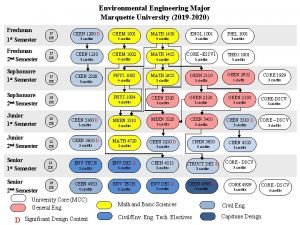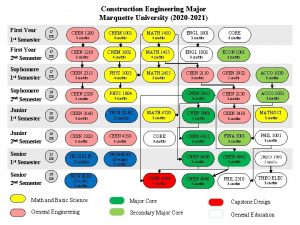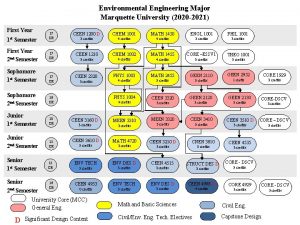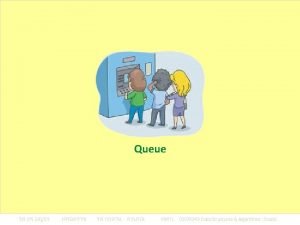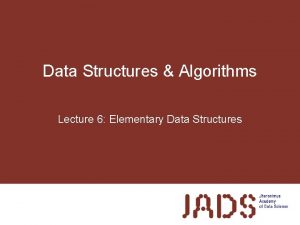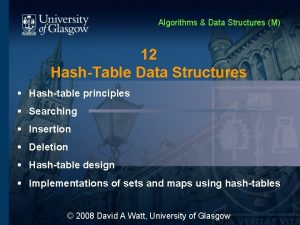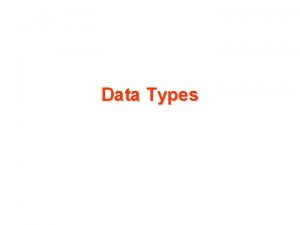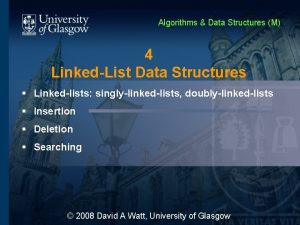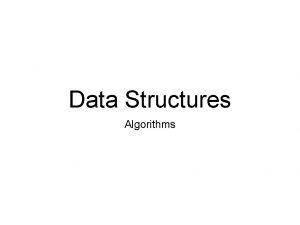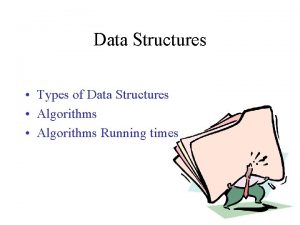Data Structures and Algorithms 2 Marquette University 2020








































































- Slides: 72

Data Structures and Algorithms 2 Marquette University 2020

Regular Expressions and Finite State Systems

Transition Diagram A man with a pet-wolf, a pet-goat, and a cabbage wants to cross a river in a boat that can only carry him and one passenger. If the man leaves the wolf and the goat alone, the wolf will eat the goat. If the man leaves the goat and the cabbage alone, then the goat will eat the cabbage. How can the man transport all three possessions to the other side of the river?

Transition Diagram A man with a pet-wolf, a pet-goat, and a cabbage wants to cross a river in a boat that can only carry him and one passenger. If the man leaves the wolf and the goat alone, the wolf will eat the goat. If the man leaves the goat and the cabbage alone, then the goat will eat the cabbage. How can the man transport all three possessions to the other side of the river? • Introduce a set of states describing possible configurations • ab: cd • • • a and b are on the original side of the river c and d are on the other side M — man, W — wolf, G — goat, C — cabbage

Transition Diagram • • Original State : MCGW • Results in three different states, but not all of them are feasible because without the man, the wolf eats the goat and the goat eats the cabbage. Three possible transaction: Men moves cabbage, goat, or wolf to other side

Transition Diagram • Transition diagram • • • States are circles Transitions move system from one state to the other Each movement is associated with a letter • The letter is the pet that the man selects to transport from one side of the river to the other

Transition Diagrams A man with a pet-wolf, a pet-goat, and a cabbage wants to cross a river in a boat that can only carry him and one passenger. If the man leaves the wolf and the goat alone, the wolf will eat the goat. If the man leaves the goat and the cabbage alone, then the goat will eat the cabbage. How can the man transport all three possessions to the other side of the river?

Finite Automata • A finite automaton consists of • • • A finite set of states A finite alphabet of inputs An initial state A set of final states A set of transitions • • Each transition is between two states and labelled with an input. Only one transition with a certain label can leave a state. A string is accepted by a finite automaton if it corresponds to a path from the starting state to a final state

Finite Automata • Formal definition • A finite automaton is a quintuple • • • where is a finite “set of states” is the “start state” is the “set of final or accepting states” is a finite set, the “alphabet” is the “transition function”

Finite Automata • • A transition moves from one state to another and consumes a single letter of input • The new state is of the old state and the letter

Finite Automata • A sequence of letters is processed by a series of transitions. • Assume the following automaton and the series 0001001011.

Finite Automata

Finite Automata

Finite Automata

Finite Automata

Finite Automata

Finite Automata

Finite Automata

Finite Automata

Finite Automata

Finite Automata

Finite Automata

Finite Automata • We can extend this to create a mapping • • Argument: • • Any state A string Image • The state in which we end up processing the string from the state

Finite Automata • Let • • be the set of strings with letters in the alphabet is the empty string Extend to by defining

Finite Automata • Example: • First for the empty string and strings with one letter

Finite Automata • Example: • Then for strings of length 2

Finite Automata

Finite Automata • Acceptance • A string w is accepted by a finite automaton iff • With other words, the string transitions from the starting state to an accepting state

Finite Automata • Programming Finite State Machines • • Easy if you can use goto and labels • Otherwise: Unfortunately, too many language designers decided that you should not be lead into temptation • • Use an enumeration data structure for the states Express the transition function as a dictionary • • Or in Java, as an array Keep track of the current state

Finite Automata • This finite automaton accepts those strings that have an even number of ones and an even number of zeroes • Lemma: The automaton is in a left state iff it has seen an even number of ones • Lemma: The automaton is in a upper state iff it has seen an even number of zeroes • Proofs by induction on the length of a string

Non-deterministic Finite Automata • Non-determinism can make it easier to design finite automata • The transition function can be multivalued • It is a function whose values are subsets of Q

Non-deterministic Finite Automata • Recognize all strings in repeated 0 or a repeated 1 • with a Rule: A string is accepted if there is a path labeled by the string from the starting state to an accepting state

Non-deterministic Finite Automata

Non-deterministic Finite Automata • As before, extend transition function to all strings

Non-deterministic Finite Automata

Non-deterministic Finite Automata • Proof sketch: • Key idea: The states of the deterministic automaton are the subsets of the non-deterministic automaton • To calculate a transition from a subset X of states, form • Accepting states: Those subsets that contain an accepting state • Can show: A string is accepted in the NFA only if it is accepted in the DFA

Non-deterministic Finite Automata 0 1 {A} {A, B} {A, D} {A, B, C} {A, D} {A, B} {A, D, E} {A, B, C} {A, C, D} {A, B, C} {A, C, D, E} {A, B, E} {A, D, E} {A, B, C, E} {A, C, D, E} {A, B, C, E} {A, C, D, E}

Non-deterministic Finite Automata • Resulting DFA

Non-deterministic finite automata with ε-moves • A further generalization of non-deterministic finite automata are non-deterministic automata with ε - moves • Example: Strings in increase. whose digits only How does this automaton accept 0000222?

Non-deterministic finite automata with ε-moves • Transition function

Non-deterministic finite automata with ε-moves • We can reduce non-deterministic finite automata with ε-moves to nondeterministic automata • For any state and letter of the alphabet Σ, calculate the states that can be reached by using ε-transitions and a single transition with the letter. • Any state that can reach an accepting state by ε-moves is accepting

Regular Expressions • Regular expressions define subsets of strings in an finite alphabet Σ • Concatenation: • Powers: • Kleene Closure

Regular Expressions • Example:

Regular Expressions • Regular expressions are defined by induction • • is a regular expression and denotes the empty set is a regular expression and denotes the set If the set then is a regular expression and denotes If are regular expressions for the sets so are then

Regular Expressions • Examples for

Regular Expressions and Deterministic Finite Automata • We want to show that regular expressions are exactly those recognized by a finite automaton. • The proof follows a simple scheme

Regular Expressions and Deterministic Finite Automata • Regular expressions are recognized by non-deterministic finite automata with ε-transitions • Base steps

Regular Expressions and Deterministic Finite Automata • Union r+s: Get two machines that recognize r and s • • Connect a new start state to the start states of the two machines Connect all final states with a new, single final state

Regular Expressions and Deterministic Finite Automata • Concatenation

Regular Expressions and Deterministic Finite Automata • Closure

Regular Expressions and Deterministic Finite Automata • Example

Regular Expressions and Deterministic Finite Automata • Now, we need to show that every language accepted by a deterministic finite automaton is regular. • • Given a DFA Define • • Set of strings that go from State i to State j without going through any state numbered higher than k We can define by recursion

Regular Expressions and Deterministic Finite Automata • Observation: • • • is given by a regular expression Proof by induction on k Base: k = 0 • is a finite set of strings with a single symbol or ε Induction step: k —> k+1 • • By induction hypothesis, we have regular expressions such that Simply define a regular expression for by

Regular Expressions and Deterministic Finite Automata • It follows that the language accepted by a DFA is regular:

Regular Expressions and Deterministic Finite Automata • Example: k=0 0 1 0+1 k=2

Regular Expressions and Deterministic Finite Automata • Example: k=0 k=1 k=2

Regular Expressions and Deterministic Finite Automata • Example: k=0 k=1 k=2

Regular Expressions and Deterministic Finite Automata • Example: k=0 k=1 k=2

Regular Expressions and Deterministic Finite Automata • Example: k=0 k=1 k=2

Regular Expressions and Deterministic Finite Automata • Example: k=0 k=1 k=2

Regular Expressions and Deterministic Finite Automata • Example: k=0 k=1 k=2

Regular Expressions and Deterministic Finite Automata • Example: k=0 k=1 k=2

Regular Expressions and Deterministic Finite Automata • Example: k=0 k=1 k=2

Regular Expressions and Deterministic Finite Automata • Example: k=0 k=1 k=2

Regular Expressions and Deterministic Finite Automata • Example: k=0 k=1 k=2

Regular Expressions and Deterministic Finite Automata • Example: k=0 k=1 k=2

Regular Expressions and Deterministic Finite Automata • Example: k=0 k=1 k=2

Regular Expressions and Deterministic Finite Automata • Therefore

Finite Automata with Output • Moore machines • Whenever the machine is in state i it outputs a symbol depending on the state • Example: • • A Moore machine that calculates the remainder modulo 3 of a binary number To derive the formula, consider

Finite Automata with Output

Finite Automata with Output • Mealy Machines • Output depends on the current state and the transition

Finite Automata with Output • It can be shown that Mealy and Moore machines are equivalent
 Professor ajit diwan
Professor ajit diwan Cos 423 princeton
Cos 423 princeton Data structures and algorithms tutorial
Data structures and algorithms tutorial Information retrieval data structures and algorithms
Information retrieval data structures and algorithms Data structures and algorithms bits pilani
Data structures and algorithms bits pilani Data structures and algorithms iit bombay
Data structures and algorithms iit bombay Data structures and algorithms
Data structures and algorithms Data structures and algorithms
Data structures and algorithms Waterloo data structures and algorithms
Waterloo data structures and algorithms Information retrieval data structures and algorithms
Information retrieval data structures and algorithms Data structures and algorithms
Data structures and algorithms Algorithms + data structures = programs
Algorithms + data structures = programs Marquette method classes
Marquette method classes Thomas schwarz marquette university
Thomas schwarz marquette university Homologous structures
Homologous structures Marquette and joliet accomplishments
Marquette and joliet accomplishments Marquette nfp perimenopause
Marquette nfp perimenopause Sjcontents
Sjcontents Red wings marquette prison
Red wings marquette prison Marquette web design
Marquette web design Stream data model
Stream data model Conditional macro expansion example
Conditional macro expansion example Assembler algorithm and data structures
Assembler algorithm and data structures Data structures and abstractions with java
Data structures and abstractions with java Adts, data structures, and problem solving with c++
Adts, data structures, and problem solving with c++ Data structures and algorithm
Data structures and algorithm Ephemeral data structure
Ephemeral data structure Computational thinking algorithms and programming
Computational thinking algorithms and programming Design and analysis of algorithms syllabus
Design and analysis of algorithms syllabus Association analysis: basic concepts and algorithms
Association analysis: basic concepts and algorithms Computer arithmetic: algorithms and hardware designs
Computer arithmetic: algorithms and hardware designs Algorithms for select and join operations
Algorithms for select and join operations Algorithms and flowcharts
Algorithms and flowcharts Undecidable problems and unreasonable time algorithms.
Undecidable problems and unreasonable time algorithms. Cluster analysis basic concepts and algorithms
Cluster analysis basic concepts and algorithms Randomized algorithms and probabilistic analysis
Randomized algorithms and probabilistic analysis Design and analysis of algorithms introduction
Design and analysis of algorithms introduction Algorithms for query processing and optimization
Algorithms for query processing and optimization Synchronization algorithms and concurrent programming
Synchronization algorithms and concurrent programming Parallel and distributed algorithms
Parallel and distributed algorithms Lerp
Lerp Cluster analysis basic concepts and algorithms
Cluster analysis basic concepts and algorithms Cjih
Cjih Algorithms for recovery and isolation exploiting semantics
Algorithms for recovery and isolation exploiting semantics Digital signal processor architecture
Digital signal processor architecture Parametric and non parametric algorithms
Parametric and non parametric algorithms Exercise 24
Exercise 24 Binary search in design and analysis of algorithms
Binary search in design and analysis of algorithms Introduction to the design and analysis of algorithms
Introduction to the design and analysis of algorithms Undecidable problems and unreasonable time algorithms
Undecidable problems and unreasonable time algorithms Design and analysis of algorithms
Design and analysis of algorithms Design and analysis of algorithms
Design and analysis of algorithms Cluster analysis basic concepts and algorithms
Cluster analysis basic concepts and algorithms Design and analysis of algorithms
Design and analysis of algorithms Btechsmartclass c
Btechsmartclass c Types of data structures in r
Types of data structures in r Oblivious data structures
Oblivious data structures Kernel data structures
Kernel data structures Introduction to data structures
Introduction to data structures Introduction to data structures
Introduction to data structures Esoteric data structures
Esoteric data structures Geometric data structures
Geometric data structures What is hadoop i/o
What is hadoop i/o Advanced data structures in java
Advanced data structures in java Debasis samanta data structure
Debasis samanta data structure Persistent vs ephemeral data structures
Persistent vs ephemeral data structures Php data structures
Php data structures Gis data structure types
Gis data structure types Dynamic data structure in java
Dynamic data structure in java Recurrence data structures
Recurrence data structures Data structures in c ppt
Data structures in c ppt Data structures for parallel computing
Data structures for parallel computing Data structures for language processing
Data structures for language processing













